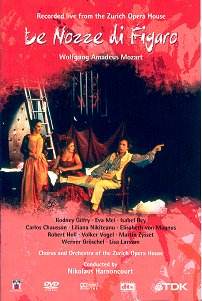One knows with Nikolaus Harnoncourt to expect the unexpected,
but who would suppose that the dimly lit figure waving a stick in a
resolute four-in-a-bar would transpire, as the camera finally moves
from its position at the very back of the stalls in the Overture, to
be one of the pioneers of the period instrument movement? Not I; but
then Harnoncourt’s cello-playing, Viennese heritage shows through his
eccentric side to consistently spacious and intelligent effect in this
Figaro. You may, as I did, find many of the arias hang fire at first;
perhaps it’s only as Eva Mei’s Countess pours her disconsolate heart
into ‘Porgi Amor’ at the start of Act 2 that I fully entered Mozart’s
and da Ponte’s (and Harnoncourt’s and Jurgen Flimm’s) world of comedy
teetering on despair, but once there, I was entranced.
And this is Flimm’s Figaro as much as it is Harnoncourt’s.
You might call both of their approaches ‘Tradition renewed’: the bed,
wedding veil and letter pin are all there (how could it be otherwise),
but they carry an air of impermanence which is entirely healthy for
this, most popular of Mozart’s operas. Acts 2 and 4 carry the necessary
charge of tension which lead you to think how it could so easily be
otherwise. Will Cherubino really escape the Count’s imprecations? Can
Figaro really be Marcellina’s son? Can the Countess really forgive her
husband? Well, for today, maybe. That the barely suppressed violence
on stage complements the explosive accents from the pit is a credit
to Rodney Gilfry’s relentlessly minatory Count, unyielding of voice
and mercy, but a linchpin in the stage action. Carlos Chausson cuts
an authentic dash as Figaro, all dark brows, flowing locks and flashing
glances. It takes all of his musical and dramatic abilities to keep
‘Se vuol ballare’ aloft at Harnoncourt’s leaden plod.
Isabel Rey, a name new to me, bears her taxing burdens
(Susanna is the longest role of the opera, and one of the most taxing
in all Mozart) with all the energy of the maid she portrays. She falls
just as easily on the ear as Alison Hagley in the rival DVD version
and both of them characterise the tensions of the role with great sympathy.
One of the set’s highlights is to see Susanna and the Countess cooing
and almost fighting over Cherubino in Act 2, the latter imperious but
prey to her affections, the former meek but a mistress of her emotions.
Elizabeth von Magnus makes a sweet-toned and unusually unshrewish Marcellina;
her problem, if it is a problem, is that she looks no older than Susanna
(making the latter’s taunts of ‘decrepit old witch’ look pretty hollow)
and sounds quite similar. Liliana Nikiteanu’s saucy page is just as
fresh-voiced.
The set has only one competitor, but it is a strong
one. Peter Hall’s production for the reopening of Glyndebourne is more
traditional in appearance but hardly less insightful, just as well sung
and conducted with more Mozartian brio by Bernard Haitink. Harnoncourt
offers rather more than the quirky take that his reputation might lead
you to expect, with some young voices that you may well want to hear
more of; I certainly do.
Peter Quantrill


